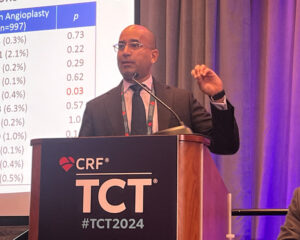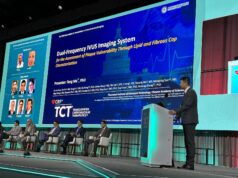
The routine use of orbital atherectomy prior to percutaneous coronary intervention (PCI) in severely calcified lesions does not improve outcomes compared to conventional balloon angioplasty, findings of the ECLIPSE clinical trial have shown.
The large-scale trial, that enrolled more than 2,000 patients at over 100 sites throughout the USA, showed that the two strategies were similar for a primary clinical endpoint of target vessel failure (TVF), defined as the composite of cardiac death, target vessel-related myocardial infarction, or ischemia-driven target vessel revascularisation at one year follow-up.
The results were presented by Ajay Kirtane (Columbia University Irving Medical Center, New York, USA) at TCT 2024 (27–30 October, Washington, DC, USA), and have led one investigator in the study to conclude that orbital atherectomy should be “reserved for the most extreme cases”, including those where the operator does not believe that balloon angioplasty would be likely to safely cross or predilate the calcified lesion.
From March 2017 to April 2023, a total of 2,005 patients (2,492 lesions) were enrolled, with a mean a age of 70 years. Among the patient cohort 27% were female, 44% had diabetes and 24% had chronic kidney disease.
By angiographic core laboratory analysis, mean reference vessel diameter was 3mm, mean lesion length was 28.7 mm, and 97.1% of lesions met criteria for severe calcification. A large proportion (62%) of patients underwent intravascular imaging in the trial.
Patients were randomised after successful wire crossing to either the orbital atherectomy strategy (n=1,008) or conventional balloon angioplasty (n=997) prior to second generation drug-eluting stent implantation and optimisation. Procedural complications were largely similar between groups.
The primary imaging endpoint consisted of the acute post-PCI minimal stent area at the site of maximum calcification as assessed by optical coherence tomography (OCT) in a pre-specified cohort of 555 subjects. Stent areas were not appreciably different between the two groups, the investigators reported.
The primary clinical endpoint of TVF at one year follow-up occurred in 11.5% in the orbital atherectomy group compared with 10% in the traditional balloon angioplasty group. The two secondary endpoints of procedural success and strategy success without the need for crossover were similar between both groups.
“Compared with conventional balloon angioplasty, the routine use of orbital atherectomy did not reduce minimal stent area or target vessel failure,” said Kirtane. “The high use of intravascular imaging within this trial was remarkable and was associated with improved outcomes in both treatment groups. But the take home message for me is that we showed that adequate stent expansion and low rates of adverse outcomes are achievable with conventional balloon angioplasty if meticulous attention is paid to lesion preparation, further highlighting the importance of randomised trials to inform treatment strategies.”













